 |
Most attempts at superlatives for an art form as rich and varied as serious music may be interesting and valid springboards for discussion but ultimately hard to defend.  Beyond purely subjective claims (my favorite this, the prettiest that), even those with a pretense of objectivity are purely speculative. Yet, one claim seems secure – it's tough to think of a more influential work than Beethoven's Ninth Symphony (known as the "Choral"). Beyond purely subjective claims (my favorite this, the prettiest that), even those with a pretense of objectivity are purely speculative. Yet, one claim seems secure – it's tough to think of a more influential work than Beethoven's Ninth Symphony (known as the "Choral").
The descriptive title stems from the finale, in which soloists and chorus sing portions of Frederich Schiller's poem "An die Freude" (Ode to Joy").  Written in 1785, Schiller's Ode reflected the doctrine of Enlightenment, the late 18th century philosophy that reason would lead to perfect harmony and pure social justice for all mankind. Disillusioned over the abuses of power of the French Revolution, Schiller himself soon came to disavow his Ode. Yet Beethoven clung to its idealism and may have tried to set it to music in the 1790s and again in 1812. After years of sketches, in 1817 he began the first two movements of a new symphony, and devoted an entire year to completing it only after creating his massive "Diabelli" Variations and Missa Solemnis in 1823, supreme masterpieces that culminated his piano and vocal writing. As late as a few months before the premiere of the Ninth, Beethoven himself had doubts about a choral finale and prepared an entirely different purely instrumental alternative (later used in his Op. 132 Quartet). Written in 1785, Schiller's Ode reflected the doctrine of Enlightenment, the late 18th century philosophy that reason would lead to perfect harmony and pure social justice for all mankind. Disillusioned over the abuses of power of the French Revolution, Schiller himself soon came to disavow his Ode. Yet Beethoven clung to its idealism and may have tried to set it to music in the 1790s and again in 1812. After years of sketches, in 1817 he began the first two movements of a new symphony, and devoted an entire year to completing it only after creating his massive "Diabelli" Variations and Missa Solemnis in 1823, supreme masterpieces that culminated his piano and vocal writing. As late as a few months before the premiere of the Ninth, Beethoven himself had doubts about a choral finale and prepared an entirely different purely instrumental alternative (later used in his Op. 132 Quartet).
In contrast to the lofty ideals its words convey, the friction and intrigue of the chaotic May 7, 1824 premiere reflected Beethoven's more venal side (which, indeed, is perhaps why his work is so accessibly human). With offers from both London and Berlin for what would be his first public concert in a decade, Beethoven relented to remain in his native Vienna only after the local elite begged for the honor. But by the time the theatre was selected, musicians hired and the date set, only three days were left to rehearse over two hours of wholly new and deeply challenging music – not only the symphony but an overture (the Consecration of the House) and three movements from his Missa Solemnis. Although the performance itself must have been little better than a tentative sight-reading, the house was sold out. Yet, due to the extraordinary expense of orchestra, chorus and soloists, profits were minimal and after accusing his colleagues of cheating him Beethoven stormed out of the celebratory dinner. A poorly attended repeat performance was a financial failure and would be the last concert of Beethoven's career.
While attention tends to focus on the choral finale, the opening of the work is every bit as momentous. Sir Donald Tovey called it "a radiating point for all subsequent experiments for enlarging the time-scale of music.

The opening of Beethoven's Ninth
-- uncertain tonality, melody and rhythm |
No later composer has escaped its influence." Among the great predecessor symphonists, Mozart got right down to business with his opening theme and while Haydn often used slow introductions, they immediately established the key and served as a logical bridge to the exposition. Indeed, Beethoven himself followed these models in each of his eight prior symphonies. The beginning of the Ninth, though, is utterly novel. Maynard Solomon cites the "sense of expectancy, soon to be fulfilled by a quickening into life, … a riddle to be solved in the rest of the piece." Never before had a symphony begun with pure atmosphere and suspense, in which the composer obscures and then teases with all three basic elements of music – tonality, rhythm and melody – which he deliberately leaves receptive to all possibility. An open fifth, the most ancient and mysterious interval of music, here of A's and E's, suggests either A major or minor. The pulse sounds like a rhythm-less tremolo, but is notated as sextolets (groups of six notes played in the time of four), hovering between duple or triple meter. Notes (A's and E's) begin to cascade, mere building-blocks of nascent melody. Gradually but purposefully, these amorphous elements coalesce into a sharp, powerful dotted theme that boldly and resolutely plunges two octaves in an insistent 2/4 time and pounds home d-minor (of which the hints of A turn out to be the dominant).
That's just the first half-minute! The entire first movement is a hugely dramatic yet cohesive voyage through the exposition, development and recapitulation of established sonata form, which Beethoven caps with a fitting coda that seamlessly returns to the mystery of the introduction – a growling, sinuous chromatic figure spreads upward from the bass, coalescing menacing fragmentary allusions of the dotted rhythm and octave leaps of the opening into a massive final affirmation of the initial theme.
The second movement, a fugal scherzo,

The opening of the scherzo
-- a melody of tympani and silence |
brilliantly combines nervous tension and joyous outbursts. Although often overshadowed by the others, it, too, begins with a startling innovation of tympani (tuned drums) being used not only in their customary role as rhythmic reinforcement but as a melodic solo. Beethoven's liberation of this formerly subsidiary instrument undoubtedly inspired Berlioz (in his Symphonie Fantastique), Mahler (his Sixth Symphony), Stravinsky (his Rite of Spring) and so many others, and even arguably paved the way for improvisational uses and experimentation that ultimately would enrich jazz and pop drumming. Another major advance was Beethoven's use of silence as a musical element – of the eight bars of the theme, four contain no notes whatever. The concept of treating sound and quiet as equal musical components is thoroughly modern, and an essential foundation for minimalism and aleatory music
The third movement is the most formally conventional of the four, a meltingly lovely, yearning reverie of variations on two complementary themes that lulls an audience for the emotional complexity of the closing movement. Indeed, the finale baffled its first listeners, led early critics to claim disappointment over what they perceived as an unwieldy and senseless conclusion that spoiled an otherwise worthy and largely conventional work, and was even omitted from many early performances. Yet, the miracle of this movement is perhaps the composer's most significant achievement of all and the most profound proof of his genius –
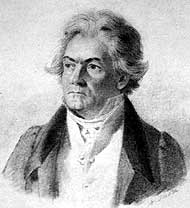
Chalk drawing of Beethoven by Stefan Dreker in 1824 |
Beethoven takes a seemingly random and unrelated grab-bag of ideas and manages to integrate them into a structure that's not only thoroughly cohesive but immeasurably enriched by the diversity of its components (and thus symbolically illustrates his theme of the universality of mankind). Indeed, Beethoven doesn't defy but rather transcends rationality.
In major part, Beethoven's extraordinary universal vision arose from private tragedy. Over the prior two decades Beethoven had become entirely deaf, the worst possible loss for a musician and one which constantly plunged him into despair. Yet, although a personal curse, his affliction became a giant boon to mankind, as it liberated him from the realm of actual sound and enabled him to hear on a level that others couldn't even begin to imagine. The depth of Beethoven's immersion into a world of his own was apparent at the premiere. Although Beethoven conducted, he became so lost in himself that he continued to beat time long after the piece was over (the players had taken their cues from another musician) – only when the alto soloist took his arm and turned him to face the audience's ovation did he realize what had happened.
Commentators have variously viewed the finale as being in sonata or rondo form, but either is barely recognizable – the opening and coda are longer than the body, and the mood consistently stretches for innovation rather than resides in the comfort of familiarity. Beethoven previously had experimented with symphonic form – the finale of his Fifth had recalled the previous movement, to which it was welded in a seamless transition, and his Sixth interrupted the flow from scherzo to finale with a thunderstorm – but never to this degree. Beethoven even had grafted a chorus onto the end of his 1808 Choral Fantasia, but it emerged as an awkward construction on a trite melody which Alfred Eisenstein likened to "a building with girders still showing through the masonry."
The finale begins with a bitter confused outburst of winds and brass to clear the air, all the more shocking following the soft contentment of the leisurely adagio. The celli and basses next "speak" together in a wordless passage that Beethoven labels "selon le caractère d'un recitative, mais in tempo" ("in the character of a recital, but in tempo"); indeed, text isn't missed, as the expressive speech-like inflection clearly signals confused questioning blended with dissatisfaction and impatience. Next, the orchestra summons fragments of the preceding three movements, each of which the celli and basses interrupt and reject.

The "Ode to Joy" melody |
They seem to mellow only when the orchestra suggests a fragment of a wholly new theme – the now-famous "Ode to Joy" melody that Beethoven, a deliberate and thoughtful composer, reportedly finalized into an ideal blend of the imposing and noble with the accessible and plain after two hundred attempts that scholars have traced through his many sketchbooks. (The theme itself would take on a life of its own, enthralling politicians and public alike, and ultimately co-opted for a huge variety of social purposes, ranging from the exalted – a symbol of the French Republic and, most recently, the European anthem – to the perverse – a song for a children's chorus in Auschwitz, and an emblem of the Rhodesian apartheid regime.) Satisfied with the initial statement of the full theme by the celli and basses, the orchestra harmonizes and repeats it four times toward a rousing and triumphant climax. When voices finally enter after a repeat of the opening outburst, a solo baritone states explicitly what the orchestral forces suggested so effectively, his actual text (added by Beethoven) seeming prosaic in comparison: "O freunde, nicht diese Töne! Sondern last uns angenehmere anstimmen und freudenvollere!" ("Oh friends, not these sounds! Let us sing more cheerful songs, more full of joy!") Then he plunges into the "Ode" theme, followed by soloists and full chorus in mythological paeans to brotherhood, friendship and nature.
To describe the rest would only diminish its splendor 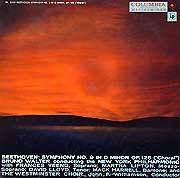 – suffice it to say that it's a staggeringly bold and effective mix of disparate elements ranging from a trite and noisy Turkish military march to a sublime awestruck quest for the Almighty. Yet, appropriately, Beethoven saves his ultimate masterstroke for the very end – a brief, incongruous, breathless coda with a wholly new tempo and theme that he leaves undeveloped and peremptory, as if to say that, having poured himself into this massive effort, all the inspiration he could muster is mere preparation for something even greater but which he cannot provide; rather, he leaves us suspended on a threshold for others to grasp and extend. Thus Beethoven ends his greatest work not with a triumphant conclusion but rather with an open-ended visionary challenge. – suffice it to say that it's a staggeringly bold and effective mix of disparate elements ranging from a trite and noisy Turkish military march to a sublime awestruck quest for the Almighty. Yet, appropriately, Beethoven saves his ultimate masterstroke for the very end – a brief, incongruous, breathless coda with a wholly new tempo and theme that he leaves undeveloped and peremptory, as if to say that, having poured himself into this massive effort, all the inspiration he could muster is mere preparation for something even greater but which he cannot provide; rather, he leaves us suspended on a threshold for others to grasp and extend. Thus Beethoven ends his greatest work not with a triumphant conclusion but rather with an open-ended visionary challenge.
The depth of that challenge is unprecedented, before or since – no other piece of music has inspired such consistently fervent admiring commentary from such a broad variety of critics and eras. Notably, foremost among the recurring critical themes is its sheer emotional scope and impact that no other work has ever matched. Thus, a reviewer of the world premiere proclaimed: "Beethoven's inexhaustible genius has opened up a new world for us, has disclosed wondrous secrets of the holy art, hitherto unknown and wholly unsuspected." Lawrence Gilman cited its "strange blend of fatefulness and transport, wild humor and superterrestrial beauty, mystery and exhaltation, tragical despair and shouting among the stars." To Alfred Eisenstein, it "throws a bridge over abysses of despair, distraction and fond yearnings, to the goal of mankind reconciled in brotherly love and certainty of God's fatherly goodness." W.H. Haddow felt he was "no longer listening to music but standing face to face with the living world."
The influence of the Ninth on musicians is equally potent and unique, as it expanded the scope of the symphony in length, breadth and outlook. 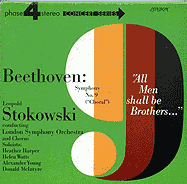 Previously, the longest symphony (Beethoven's Third) ran about 45 minutes, with the vast majority a half-hour or less, and served as a portion of a concert program, a mere diversion amid other delights. The Ninth, though, presented an entire world of expression; it was hard to precede and virtually impossible to follow in a concert. Historically, it bridged the former absolute gap between the vocal music of opera and oratorio and purely instrumental symphonic music (or, more symbolically, between specific textual references and abstract suggestion, or between functional and conceptual music). Aesthetically, it represents the first unfettered outburst of pure emotion in an art previously governed by formal restraint. While Bach, Mozart and other predecessors found infinite degrees of expression within the established forms of their time and pushed their envelopes with a subtle genius, Beethoven transcended his models, paving the way for future generations not only to explore his new forms but to grasp his spirit and to invent new forms of their own. More than any other musician before or since, Beethoven was a liberating force who changed the very underlying attitude of artistic creation. Any musician who feels an irrepressible urge to do his own thing is one of Beethoven's spiritual heirs. Previously, the longest symphony (Beethoven's Third) ran about 45 minutes, with the vast majority a half-hour or less, and served as a portion of a concert program, a mere diversion amid other delights. The Ninth, though, presented an entire world of expression; it was hard to precede and virtually impossible to follow in a concert. Historically, it bridged the former absolute gap between the vocal music of opera and oratorio and purely instrumental symphonic music (or, more symbolically, between specific textual references and abstract suggestion, or between functional and conceptual music). Aesthetically, it represents the first unfettered outburst of pure emotion in an art previously governed by formal restraint. While Bach, Mozart and other predecessors found infinite degrees of expression within the established forms of their time and pushed their envelopes with a subtle genius, Beethoven transcended his models, paving the way for future generations not only to explore his new forms but to grasp his spirit and to invent new forms of their own. More than any other musician before or since, Beethoven was a liberating force who changed the very underlying attitude of artistic creation. Any musician who feels an irrepressible urge to do his own thing is one of Beethoven's spiritual heirs.
(And let's not forget that on a more practical level, the influence of the Ninth is with every one of us, even those who wouldn't be caught dead listening to serious music – the Japanese engineered the capacity of the Compact Disc system to accommodate the Ninth on a single side.)
Long regarded as the Everest challenging conductors, Beethoven's Ninth has inspired an extraordinary variety of recorded interpretations. 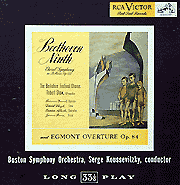 Although Richard Strauss reportedly dispatched it in a mere 45 minutes, recordings range from 54 to 78 minutes. (For meaningful comparison, all timings given here are shorn of repeats.) The differences in timing mostly lie in tempos, and there lies a tale. It's indeed ironic that scholars vigorously research and advocate minute changes in single accidentals, ostensibly to get incrementally closer to Beethoven's original conception, yet routinely dismiss his tempo markings as far too fast. As a means of ensuring accurate renditions of his work, Beethoven revered the metronome, then recently invented by his friend Nepomuk Mälzel, to whom the deaf composer was indebted for his prior work perfecting the ear-trumpet (an early acoustical hearing-aid). For his publisher, Beethoven wrote out a set of specific metronome tempos. Thus, for the opening of the Ninth, in addition to the standard verbal indication ("Allegro, ma non troppo, un poco maestoso" – "Fast, but not too much, a bit majestic"), Beethoven specifies 88 quarter-notes per minute. Yet few performers take these seriously, much less observe them. Rationales range from the absurd (Beethoven's deafness deprived him of the ability to sense time) to the speculative (his metronome was not adjusted properly) to the egotistical (conductors know better) to the scientific (the resonance of modern halls expands the feeling of sonic space and thus demands deliberation) to the practical (Beethoven's overall plan remains intact so long as tempos remain relative to those he specified). Although Richard Strauss reportedly dispatched it in a mere 45 minutes, recordings range from 54 to 78 minutes. (For meaningful comparison, all timings given here are shorn of repeats.) The differences in timing mostly lie in tempos, and there lies a tale. It's indeed ironic that scholars vigorously research and advocate minute changes in single accidentals, ostensibly to get incrementally closer to Beethoven's original conception, yet routinely dismiss his tempo markings as far too fast. As a means of ensuring accurate renditions of his work, Beethoven revered the metronome, then recently invented by his friend Nepomuk Mälzel, to whom the deaf composer was indebted for his prior work perfecting the ear-trumpet (an early acoustical hearing-aid). For his publisher, Beethoven wrote out a set of specific metronome tempos. Thus, for the opening of the Ninth, in addition to the standard verbal indication ("Allegro, ma non troppo, un poco maestoso" – "Fast, but not too much, a bit majestic"), Beethoven specifies 88 quarter-notes per minute. Yet few performers take these seriously, much less observe them. Rationales range from the absurd (Beethoven's deafness deprived him of the ability to sense time) to the speculative (his metronome was not adjusted properly) to the egotistical (conductors know better) to the scientific (the resonance of modern halls expands the feeling of sonic space and thus demands deliberation) to the practical (Beethoven's overall plan remains intact so long as tempos remain relative to those he specified).
The problem is most acute for the trio of the scherzo, to which Beethoven assigned a metronome marking of a wildly fast 116 half notes to the minute. Nearly all conductors consider this to have been an error for a far more reasonable 116 quarter notes. However, that's the very same tempo as the opening section, after which Beethoven indicated an acceleration. So most conductors chose an arbitrary pace of 140 or so quarter notes per minute that seems to make musical sense.

The lead-in and the first movement theme |
A less debatable lapse is the smoothing of a deliberately jagged and startling rhythm that precedes the eruption of the initial dotted theme. In measure 15, Beethoven prepares the initial climax with an emphatic, tottering figure of octave A's, whose solid rhythm tricks our ears into sounding as if it falls squarely on the beat. In fact it is syncopated and leads into the momentous downbeat of the theme with only the slightest pause (a thirty-second rest and pickup note). Yet nearly all conductors blunt the impact by adding an extra beat. While the passage may sound better that way, at least to modern ears, it's not Beethoven's way.
Navigating the vast realm of recordings of the Ninth is both daunting and futile, as the work is so inherently galvanizing as to transcend all but the most perfunctory rendition. For relatively straightforward accounts,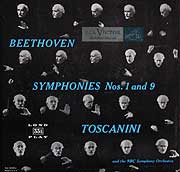 I can wholeheartedly recommend all of these (listed in approximate order ranging from virile, driven tension to magisterial breadth): Toscanini/NBC (1939, now on Music and Arts, Naxos or Relief CDs), Fried/Berlin (1928, Pearl), Szell/Cleveland (1961, Sony), Toscanini/NBC (1952, BMG), Weingartner/Vienna (1935, Naxos), Leinsdorf/Boston (1969, BMG), Horenstein/Pro Musica (1956, Vox), Munch/Boston (1958, RCA), Walter/Columbia (1959, Sony), Karajan/Berlin (1963, DG), Bernstein/NY (1964, Sony), Harnoncourt/Chamber Orchestra of Europe (1991, Teldec), Reiner/Chicago (1961, RCA), Schmidt-Isserstedt/Vienna (1966, Decca), Abbado/Berlin (either 1996, Sony or 2000, DG), Monteux/London (1966, Westminster), Klemperer/Philharmonia (1957, EMI), Bernstein/Vienna (1979, DG) and Celibidache/Munich (1989, EMI). (All but the two Abbados and Celibidache are budget-priced.) (At the extreme end of the range, the slowest of all recorded performances is the 79-minute Bohm/Vienna (1981, DG), which boasts beautifully transparent textures, but seems sterile and tired.) I can wholeheartedly recommend all of these (listed in approximate order ranging from virile, driven tension to magisterial breadth): Toscanini/NBC (1939, now on Music and Arts, Naxos or Relief CDs), Fried/Berlin (1928, Pearl), Szell/Cleveland (1961, Sony), Toscanini/NBC (1952, BMG), Weingartner/Vienna (1935, Naxos), Leinsdorf/Boston (1969, BMG), Horenstein/Pro Musica (1956, Vox), Munch/Boston (1958, RCA), Walter/Columbia (1959, Sony), Karajan/Berlin (1963, DG), Bernstein/NY (1964, Sony), Harnoncourt/Chamber Orchestra of Europe (1991, Teldec), Reiner/Chicago (1961, RCA), Schmidt-Isserstedt/Vienna (1966, Decca), Abbado/Berlin (either 1996, Sony or 2000, DG), Monteux/London (1966, Westminster), Klemperer/Philharmonia (1957, EMI), Bernstein/Vienna (1979, DG) and Celibidache/Munich (1989, EMI). (All but the two Abbados and Celibidache are budget-priced.) (At the extreme end of the range, the slowest of all recorded performances is the 79-minute Bohm/Vienna (1981, DG), which boasts beautifully transparent textures, but seems sterile and tired.)
More intriguing for those familiar with the Ninth are recordings by Mengelberg/Concertgebouw (1940, Music & Arts), Furtwangler/Philharmonia (1954, Tahra), Abendroth (Leipzig 1953, Arlecchino; Berlin 1950, Tahra; or Leipzig 1950, Tahra) and Stokowski/London (1969, Decca), who add deeply personal yet musically compelling touches. Successful attempts to replicate the more intimate and forceful "sound" of Beethoven's day, through the reduced forces, authentic instruments and performance practices of his era, are heard in the versions by the London Classical Players under Norrington (1987, EMI), the Hanover Band (1988, Nimbus) and the Academy of Ancient Music under Hogwood (1989, L'Oiseau-lyre).
Even more exciting to me, Benjamin Zander and the Boston Philharmonic Orchestra (1992, Carlton), David Zinman and the Tonhalle Orchestra Zurich (1998, Arte Nova) and John Eliot Gardiner and L'orchestre Revolutionnaire et Romantique (1992, DG) push their less-known modern-instrument ensembles to match Beethoven's breathless tempi to produce overwhelmingly convincing and heartfelt readings alive with fleet, classical grace yet teeming with aggressive revolutionary fervor.
Above all other symphonies, performances of the Ninth have long been reserved for special occasions whose emotions have produced especially compelling and distinctive interpretations. Three conductors have left recorded legacies of particular and lasting interest.
For a January 1974 memorial concert for Otto Klemperer,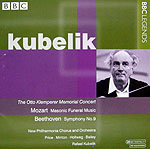 the last of the "Golden Age" conductors whose death symbolized the passing of an entire interpretive era, Rafael Kubelík guided the New Philharmonia Orchestra and Chorus – the ensembles Klemperer had led on record for two decades – in the Ninth, suitably prefaced by Mozart's Masonic Funeral Music (BBC). His reading is a confluence of personalities, cast fundamentally in the massive, steady mold of the honoree's late style, but with enough vitalizing touches to avoid strict imitation and to pay tribute from one generation to another. While Kubelík's timings are virtually identical to Klemperer's 1957 EMI studio recording, the slightly smoother respites, more ardent vocals and more striking brass and tympani accents complement, rather than challenge, the approach of the lamented master. And by plunging directly from the meditative adagio into the opening sting of the finale, Kubelík keeps the audience focused on the work's present significance rather than dwelling nostalgically on the past. the last of the "Golden Age" conductors whose death symbolized the passing of an entire interpretive era, Rafael Kubelík guided the New Philharmonia Orchestra and Chorus – the ensembles Klemperer had led on record for two decades – in the Ninth, suitably prefaced by Mozart's Masonic Funeral Music (BBC). His reading is a confluence of personalities, cast fundamentally in the massive, steady mold of the honoree's late style, but with enough vitalizing touches to avoid strict imitation and to pay tribute from one generation to another. While Kubelík's timings are virtually identical to Klemperer's 1957 EMI studio recording, the slightly smoother respites, more ardent vocals and more striking brass and tympani accents complement, rather than challenge, the approach of the lamented master. And by plunging directly from the meditative adagio into the opening sting of the finale, Kubelík keeps the audience focused on the work's present significance rather than dwelling nostalgically on the past.
Recording had captured a ferocious 1942 Berlin concert of terrifying impact led by Wilhelm Furtwängler, bristling with the agony and frustration of his desperate battle to preserve humanistic ideals within the appalling cauldron of Nazism (Music & Arts). In 1951 he rededicated the Bayreuth Festival, the symbolic core of German music which had been silenced after the War, with a concert of the Ninth in which he transmuted his former cry of desperation into a valedictory confirmation of the ultimate triumph of the artistic spirit (EMI). Despite their divergent import, both readings (and indeed all of Furtwängler's ten other known concert recordings of the Ninth) reflect a shared gesture that seems bizarre but ultimately bursts with meaning. Most conductors take the coda of the finale at a healthy clip, but Furtwängler attacks it at a superhuman pace more than twice that of any other recording – so fast that the musicians cannot possibly play the notes accurately, the musical sense is utterly lost, and the work ends in a jumble of confusion. Thus, Furtwängler treats the final sublime moment of the ultimate orchestral work of the greatest composer not with a refined and satisfying aesthetic touch of closure but with an uncontrolled explosive outburst, and by so doing reminds us just who Beethoven was – not a quaint gentle genius but the great rebel who constantly pushed music into uncharted territory and whose personality resides in every musical insurgent of our own time. Thus, by blowing away the bounds of musicianship, propriety and culture just as Beethoven himself had done, Furtwängler integrates the coda of the Ninth into the entire life, personality and outlook of its composer. At the same time his daring feat asserts Beethoven's contemporary relevance and empowers a modern listener to relive the shock Beethoven's own audience must have felt at the premiere. bristling with the agony and frustration of his desperate battle to preserve humanistic ideals within the appalling cauldron of Nazism (Music & Arts). In 1951 he rededicated the Bayreuth Festival, the symbolic core of German music which had been silenced after the War, with a concert of the Ninth in which he transmuted his former cry of desperation into a valedictory confirmation of the ultimate triumph of the artistic spirit (EMI). Despite their divergent import, both readings (and indeed all of Furtwängler's ten other known concert recordings of the Ninth) reflect a shared gesture that seems bizarre but ultimately bursts with meaning. Most conductors take the coda of the finale at a healthy clip, but Furtwängler attacks it at a superhuman pace more than twice that of any other recording – so fast that the musicians cannot possibly play the notes accurately, the musical sense is utterly lost, and the work ends in a jumble of confusion. Thus, Furtwängler treats the final sublime moment of the ultimate orchestral work of the greatest composer not with a refined and satisfying aesthetic touch of closure but with an uncontrolled explosive outburst, and by so doing reminds us just who Beethoven was – not a quaint gentle genius but the great rebel who constantly pushed music into uncharted territory and whose personality resides in every musical insurgent of our own time. Thus, by blowing away the bounds of musicianship, propriety and culture just as Beethoven himself had done, Furtwängler integrates the coda of the Ninth into the entire life, personality and outlook of its composer. At the same time his daring feat asserts Beethoven's contemporary relevance and empowers a modern listener to relive the shock Beethoven's own audience must have felt at the premiere.
Leonard Bernstein, too,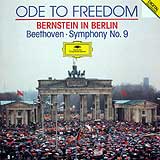 had integrated many symbolic gestures into his career as an artist and into his convictions as a human being. One of his final concerts marked the 1989 dismantling of the Berlin Wall and the reunification of Germany with a massive and sublime rendition of the Beethoven Ninth by soloists, choruses and orchestras from Berlin, Dresden, New York, London, Paris and Leningrad (representing the two Germanies and the wartime Allies). To underline the message, in the final chorus Bernstein changed the word "Freude" ("joy") to "Freiheit" ("freedom"). In their role as catalyst for the reconciliation of ideological foes and the reintegration of former enemies into the world community, the performers are palpably gripped with a spiritual conviction that intensifies the abundant glory of this astounding music, into which Beethoven had poured a sprawling summation of life's passion, profundity, humor, despair and triumph. As Paul Bekker wrote, the Ninth "rises from the sphere of personal experience to the universal. Not life itself is portrayed but its eternal meaning." had integrated many symbolic gestures into his career as an artist and into his convictions as a human being. One of his final concerts marked the 1989 dismantling of the Berlin Wall and the reunification of Germany with a massive and sublime rendition of the Beethoven Ninth by soloists, choruses and orchestras from Berlin, Dresden, New York, London, Paris and Leningrad (representing the two Germanies and the wartime Allies). To underline the message, in the final chorus Bernstein changed the word "Freude" ("joy") to "Freiheit" ("freedom"). In their role as catalyst for the reconciliation of ideological foes and the reintegration of former enemies into the world community, the performers are palpably gripped with a spiritual conviction that intensifies the abundant glory of this astounding music, into which Beethoven had poured a sprawling summation of life's passion, profundity, humor, despair and triumph. As Paul Bekker wrote, the Ninth "rises from the sphere of personal experience to the universal. Not life itself is portrayed but its eternal meaning."

Copyright 2008 by Peter Gutmann
|
